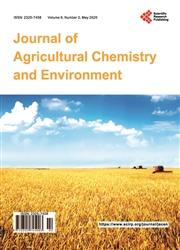Levels of Selected Essential and Non-Essential Metals in the Soil and Ginger (Zingiber officinale) Cultivated in Wolaita Zone, Ethiopia
引用次数: 0
Abstract
Ginger (Zingiber officinale) is an important spice and medicinal plant used in different parts of the world. The objective of current study was to determine the level of essential and non-essential metals in ginger and its correlation with concentration of metals in the supporting soil. The level of K, Na, Ca, Mg, Mn, Fe, Zn, Cu, Co, Cd and Pb in soil and ginger cultivated in the selected districts of Wolaita zone, Southern Ethiopia were determined using flame atomic absorption spectrometry. A 0.5 g ginger sample was digested using a mixture of 4 ml HNO3 and 1.5 ml HClO4 at 210°C for 150 minutes, and a 0.5 g soil sample was digested employing a mixture of 6 ml aqua-regia and 1 ml H2O2 at 280°C for 150 minutes. The metal concentrations range in dry weight basis for ginger samples is decreasing in the order: K (1691 - 3487 mg/kg) > Mg (701 - 1583 mg/kg) > Ca (862 - 1476 mg/kg) > Na (398 - 776 mg/kg) > Mn (325 - 672 mg/kg) > Fe (6.14 - 11.92 mg/kg) > Zn (5.30 - 10.09 mg/kg) > (0.12 - 0.23 mg/kg) for Pb. The concentration of Cd, Cu and Co in ginger samples were below the limit of detection. The results revealed that ginger has the ability to accumulate relatively higher amounts of K and Mg among the determined essential metals. The soil samples have been found to be acidic pH, sandy clay loam in texture, a very low electrical conductivity and moderate level of (CEC, organic carbon, available phosphorus and total nitrogen). Although, a positive correlation between the levels of K, Mg, Zn, Mn in ginger and soil samples were observed. All the non-essential metals analyzed in this study were below the permissible ranges set by FAO/WHO.埃塞俄比亚沃莱塔地区土壤和种植的生姜中所选必需和非必需金属的水平
姜(Zingiber officinale)是一种重要的香料和药用植物,在世界各地广泛使用。本研究的目的是确定生姜中必需和非必需金属的含量及其与支撑土壤中金属浓度的相关性。采用火焰原子吸收光谱法测定了埃塞俄比亚南部沃莱塔地区选定地区土壤和种植的生姜中的K、Na、Ca、Mg、Mn、Fe、Zn、Cu、Co、Cd和Pb含量。使用4 ml HNO3和1.5 ml HClO4的混合物在210℃下消化0.5 g生姜样品150分钟,使用6 ml王水和1 ml H2O2的混合物在280℃下消化0.5g土壤样品150分钟。生姜样品的干重金属浓度范围呈下降趋势,其顺序为:K(1691-3487 mg/kg)>mg(701-1583 mg/kg)>Ca(862-1476 mg/kg)>Na(398-776 mg/kg)>Mn(325-672 mg/kg)>Fe(6.14-11.92 mg/kg)>Zn(5.30-10.09 mg/kg)>Pb(0.12-0.23 mg/kg)。生姜样品中Cd、Cu和Co的含量均低于检测限。结果表明,在所测定的必需金属中,生姜具有相对较高量的K和Mg积累能力。土壤样品的pH值为酸性,质地为砂质粘壤土,电导率极低,(CEC、有机碳、有效磷和总氮)含量适中。尽管如此,生姜中的K、Mg、Zn、Mn水平与土壤样品呈正相关。本研究中分析的所有非必需金属均低于粮农组织/世界卫生组织设定的允许范围。
本文章由计算机程序翻译,如有差异,请以英文原文为准。
求助全文
约1分钟内获得全文
求助全文

 求助内容:
求助内容: 应助结果提醒方式:
应助结果提醒方式:


